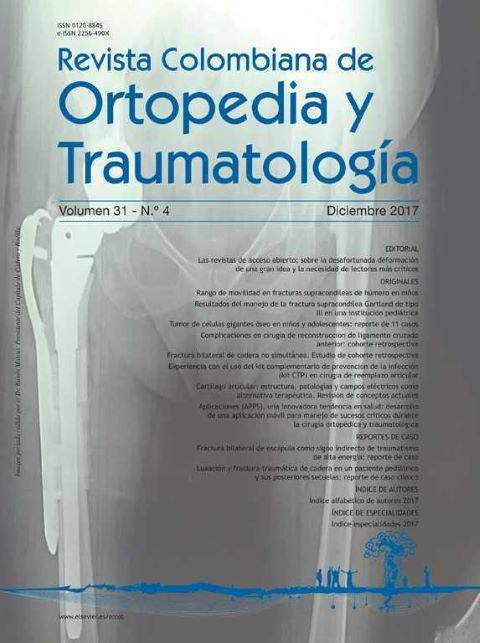Applications (APPS), an innovative health trend: development of a mobile application for the management of critical events during orthopaedic and trauma surgery
DOI:
https://doi.org/10.1016/j.rccot.2017.06.001Keywords:
APP, algorithm, intra-operative alarm, intra-operative emergencyAbstract
Background: The manner in which a critical intra-operative event is addressed can make the difference between life and death. Robust evidence shows that surgical teams do not adequately handle complications during surgery. The literature reports a rate of 145 critical events per 10,000 procedures, with medical errors being the leading cause of preventable injury and death in patients during surgery. Through a national initiative and an interdisciplinary team, we developed a software program in the form of an application (APP), for tablets and smartphones that allows to systematically deal with critical events in orthopaedic surgery. The tool was tested in high-fidelity simulation scenarios of operating theatres, with real clinical cases. To date, no similar tool has been reported in the literature.
Materials and methods: An application was developed for mobile phones and tablets in format for Android and IOS using POP (prototyping on paper) and Microsoft. This application contains a flowchart that allows the early identification of a critical event during surgery, and once detected provides the steps for appropriate coping based on the best available evidence. In a high-fidelity simulation theatre environment, the usefulness of the application and the diagrams, as well as the perception of the members of the medical team on its use were tested.
Results: The application use improved response times and adherence to critical care processes. Surgical teams reported comfort with the use of the application.
Discussion: Applications as cognitive aids have proven useful in different areas of knowledge. Given the small sample size, it is difficult to infer the significance of the results. On the other hand, the literature is conclusive as far as the usefulness of the cognitive aids for the resolution of medical problems. Initiatives, such as that proposed have the potential to improve patient safety, and are a national example of innovation for the world, and goes hand in hand with the thinking of Orthopaedics and Traumatology in Colombia.
Level of evidence: II.
Downloads
References
Arriaga AF, Bader AM, Wong JM, Lipsitz SR, Berry WR, Ziewacz JE, et al. Simulation-based trial of surgical-crisis checklists. N Engl J Med. 2013;368:246-53. https://doi.org/10.1056/NEJMsa1204720
Charuluxananan S, Punjasawadwong Y, Suraseranivongse S, Srisawasdi S, Kyokong O, Chinachoti T, et al. The Thai Anesthesia Incidents Study (THAI Study) of anesthetic outcomes: II. Anesthetic profiles and adverse events. J Med Assoc Thai. 2005;88 Suppl 7:S14-29.
Starfield B. Is US health really the best in the world? JAMA. 2000;284:483. https://doi.org/10.1001/jama.284.4.483
Novoa DC, Llinás A, Daccach JA, Navas J, Novoa DC. Resolución de emergencias durante cirugía ortopédica y traumatológica: desarrollo de un listado de verificación. Rev Col Or Trau. 2010;3:153-7.
Medicine I of. To Err Is Human [Internet]. Washington, D.C.: National Academies Press; 2000 [citado: 10 de noviembre de 2015]. Disponible en: http://www.nap.edu/catalog/9728/to-err-is-human-building-a-safer-health-system
Pronovost PJ, Weast B, Holzmueller CG, Rosenstein BJ, Kidwell RP, Haller KB, et al. Evaluation of the culture of safety: survey of clinicians and managers in an academic medical center. Qual Saf Health Care. 2003;12:405-10. https://doi.org/10.1136/qhc.12.6.405
New England Journal of Medicine Image Challenge becomes an iPhone medical app [Review] [Internet]. [citado: 12 de diciembre de 2015.] Disponible en: http://www.imedicalapps.com/2010/12/new-england-journal-medicine-iphone-imagechallenge-medical-app-review/
Kahn SR, Morrison DR, Cohen JM, Emed J, Tagalakis V, Roussin A, et al. Interventions for implementation of thromboprophylaxis in hospitalized medical and surgical patients at risk for venous thromboembolism. Cochrane Database Syst Rev. 2013: CD008201. https://doi.org/10.1002/14651858.CD008201.pub2
Andrews J, Guyatt G, Oxman AD, Alderson P, Dahm P, FalckYtter Y, et al. GRADE guidelines: 14. Going from evidence to recommendations: the significance and presentation of recommendations. J Clin Epidemiol. 2013;66:719-25. https://doi.org/10.1016/j.jclinepi.2012.03.013
Downloads
Published
How to Cite
Issue
Section
License
Copyright (c) 2024 Revista Colombiana de ortopedia y traumatología

This work is licensed under a Creative Commons Attribution 3.0 Unported License.




